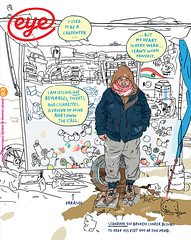Winter 2016
Permanent opposition
Perched in a London office overlooking the Thames, Peter Brookes has just hours to turn headline news into hard-hitting cartoons for
The Times, skewering vain, inane and insane politicians with meticulous craft
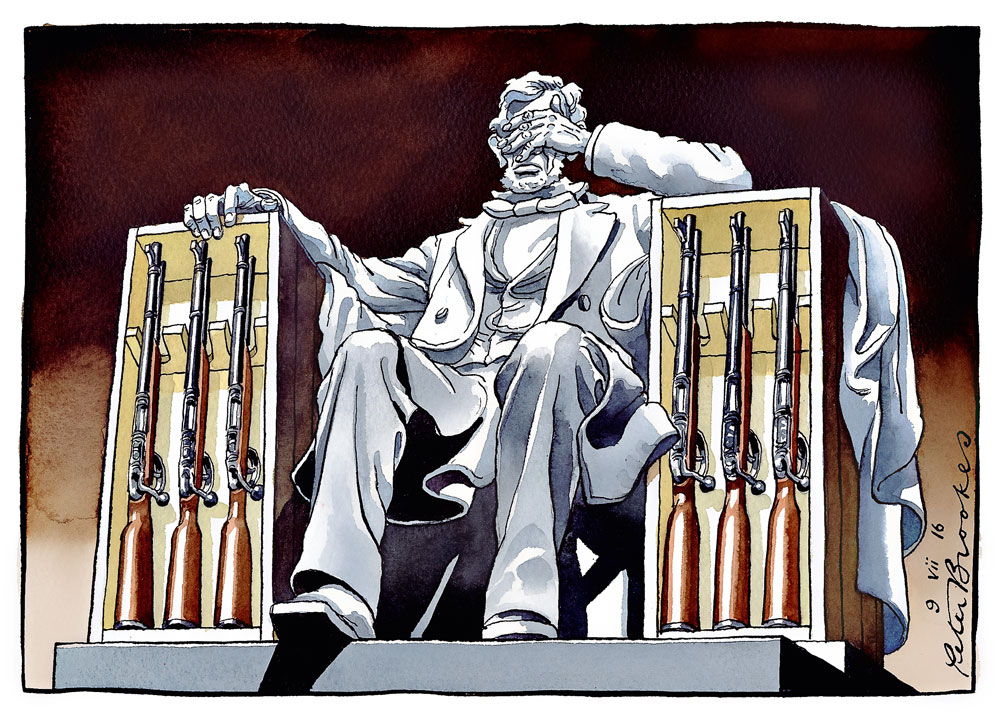
Morning
At around 9am on any given weekday Peter Brookes sits down at his drawing board in the new headquarters of The Times overlooking London Bridge, near the foot of the Shard. A £14 version of Damien Hirst’s For the Love of God, a diamond-encrusted skull, sits on his desk. He opens a can of Diet Coke, one of the many kept in his small fridge, and starts reading the news.
He picks up a copy of the morning’s Times with his cartoon of the previous day and sees how the stories of yesterday have moved on. At 10.45 he walks to the pre-conference meeting, where the newspaper’s editor John Witherow and his senior journalists float ideas before the main 11 o’clock conference, when the next day’s paper is formulated. Come midday, Brookes knows the basic shape of the news. Back in his office he scours the Web for more information on subjects that are starting to work their way though his cortex, lighting synapses, suggesting links, pulling ideas from the vast bank of visual references in his brain.
For Peter Brookes (b. 1943), the path to becoming a political cartoonist was unconventional. His father was an RAF Squadron Leader, and Peter followed in his footsteps – briefly. ‘I went into the RAF, wanted to be a pilot, was useless, got flung out,’ is how he puts it. He’d always drawn as a child at school, and he loved the illustrations of Frank Bellamy in the boy’s comic the Eagle, and cartoons in the Daily Mail by Leslie Illingworth. ‘At twelve or thirteen I wasn’t so interested in the political thinking, I just loved the way he drew,’ he told the British Cartoon Archive. He continued to draw during his time in the RAF, but, having considered it only a pastime until his rejection, decided that it was worth a try applying to art school. Although lacking qualifications, in 1965 he was accepted on a foundation course at Manchester School of Art, which led to a three-year course in Graphic Design at the Central School. Here, in London, he felt liberated. He also realised that, for him, designing came a poor second to drawing.
During Brookes’s studies at Central, David Driver – recently hired as art director to modernise the BBC’s Radio Times, at the time the biggest-selling magazine in Britain – came in to set an editorial project for the graphics students: a health article needing a conceptual approach. He recalls Peter Brookes and Pearce Marchbank (see Eye 44) standing out as particularly enthusiastic and bright students. Driver suggested Peter make an appointment to come into Radio Times with his portfolio. David’s assistant, Susan Maxwell, gave him his first job: a three-part illustration for a radio adaptation of Thomas Hardy’s The Return of the Native. He continued to work as a freelancer, doing covers for New Society and New Statesman as well as working for advertising agencies and publishers. As the work built up, he gravitated towards more politically engaged jobs, items that talked about the state of the world. In 1976 he took over Nick Garland’s slot, doing a weekly cartoon on the political scene for the New Statesman, but gave it up after a short time.
Peter Brookes photographed by Philip Sayer.
Top: The statue in the Lincoln Memorial, does duty here, brilliantly, for the USA’s troubled relationship with firearms.
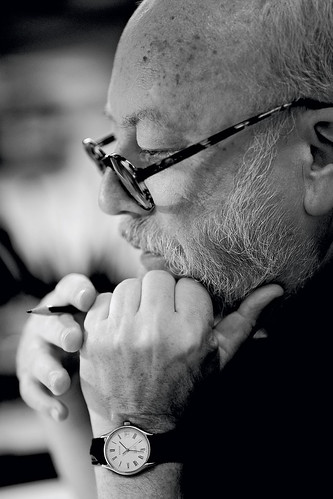
Midday
After mulling over ideas, just after midday, Brookes makes his way across the news floor to the desk of a senior Times journalist – comment editor Mike Smith. Smith is experienced and knows how cartoons work, so he is useful in clarifying Brookes’s thinking, or sparking new thoughts. Back in his workspace (apart from the editor, Brookes has the only office on the Times news floor) he picks up a soft pencil and some layout paper and he roughs out the idea that he has settled on. When it is working to his satisfaction, Brookes takes a fresh sheet of T. H. Saunders watercolour paper, and draws – by eye – a rectangular frame. He is aiming for it to be 285 millimetres wide by 200 millimetres deep, his regular slot. He picks up a ruler and measures it. On most occasions it is within a millimetre or two. The sketch is traced down on to the rectangle.
Building on Radio Times’s legacy of illustration, David Driver’s policy in the late 1970s was to introduce new artists alongside famous stalwarts such as Eric Fraser and Robin Jacques. Brookes joined them, working on infographics with Nigel Holmes, illustrating dramas and seasonal covers. At the same time he was freelancing, sometimes working with Marchbank on covers for a new magazine for London, Time Out. During this time the Radio Times provided Brookes with his first long-running slot, a comment piece on the back page called ‘Peter Brookes on …’ which gave him free rein to pick any part of the BBC output that caught his eye and do an editorial gag on it. ‘Given that the Radio Times had reviews and previews,’ Driver says, ‘I thought that an artist should be involved in that process, not drawing to illustrate a play or a theme.’
At the same time, Driver art-directed The Listener, a weekly BBC magazine that featured articles written by its programme makers. It was small but influential and Driver, looking to redesign it, suggested to editor Anthony Howard that the cover should always be a drawing. He suggested Peter Brookes. ‘He had such a good mind, such clever thinking,’ said Driver, ‘and I wanted to focus attention on him and see where he wanted to go with his work. The great thing about that experience –an important piece of the jigsaw for Peter – was that it introduced him to a political world through Tony Howard. Editorial meetings would often feature politicians as guests and Peter enjoyed that process.’
Buoyed by this trust, The Listener became an excellent proving ground. However, after a few years, Brookes’s graphics training reared up, leading him to feel that the magazine’s black, white and spot-colour red covers had become, as he puts it, ‘like wallpaper’. He thought that the title no longer stood out on the newsstand. ‘I’ve always had a graphic design strand to my thinking. Ever since I left college, I’ve regarded jobs as problem-solving,’ he says.
British Prime Minister Theresa May is slotted into a Mary Poppins film poster after May’s closing speech at the Conservative Party Conference in Manchester. Thursday 6 October 2016.
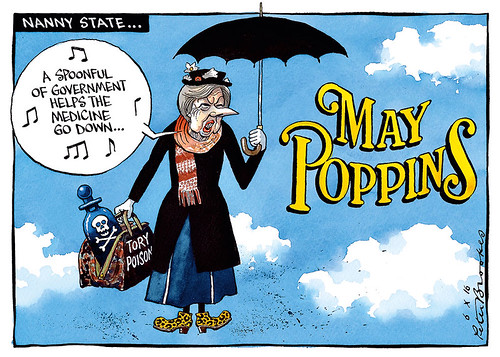
After lunch
It’s 2.30 and Brookes starts the drawing in earnest. It is time for the dip pen, its nib made by the ancient firm of Gillott, and filled with Pelikan black ink. Thus armed, he begins the process of creating a vicious likeness of today’s target, probably in a position or pose that will reveal their most craven impulses. Years of practice have made him a master draughtsman – there’s no time wasted on worrying about likeness or perspective or scenery, and he has access to the photo library at The Times for any details he is unsure of, whether that is a rock musician’s stage costume or a prison warder’s outfit.
He will also call up the reference images he is parodying. There is a joy in the research that makes the title for The Godfather perfectly mimicked, or the perspective of the subway entrance by the House of Commons so accurate. Such research also plays to one of Brookes’s greatest strengths: yoking together two totally disparate news stories – the Greek debt overlaid on a pop singer’s death, or an oil tanker run aground crossed with a politician’s promise.
When Driver moved to The Times in 1981, he brought Brookes on board to illustrate the op-ed page, as he felt that Brookes’s work was developing in a political direction. His main role was illustrating columns by commentator Bernard Levin, who once said that he ‘wrote more comfortably against the grain of the paper I worked for rather than with it.’
This remark holds true of Brookes, who is generally to the left of The Times’s editorial line. ‘Where it got interesting for me,’ says Brookes, ‘was getting a regular berth on The Times, illustrating on those op-ed pages. Then I realised, luckily at the same time as an opportunity arose, that illustrating other people’s political thoughts, or their solutions to things, is a bit of a dead end.’
Then a break came in 1982, when The Times’s political cartoonist, Ranan Lurie, decided to move on. ‘I immediately said yes, I’d love to do that – and they, in deference to me, I’m sure, said, why don’t you carry on doing what you’re doing and do two or three cartoons per week?’
In practice, Brookes found the idea of being a political cartoonist daunting. ‘This is where your own feelings of inadequacy come in, because, of course, relying on someone else’s opinion is by far the easier option … Coming to a conclusion every day – what do I think about this? God knows what I’d have done if I was doing it now – everything’s coming at you, a coup here, an outbreak there, Trump, Brexit …’
He continues: ‘And when I had one or two tricky days and I couldn’t get anything going, I’d say Oh, I’ll do an illustration instead, and that’s the worst of all worlds, as it gives you an opt-out … I lacked confidence. The editor at the time, Charlie Wilson, really tried to make it work for me, but I was adamant – so I gave it up and went back to what I’d always done.’
When Peter Stothard was made editor of The Times in 1992 and offered Brookes the chance to try again, he fully committed and gave up other freelance work. Thus began a long and extremely fruitful relationship (24 years and counting) between the ‘paper of record’ and the pen of Brookes.
In 1996, some years into his stint, the paper went through a redesign and Brookes was offered something a little different – a regular Saturday slot in colour. ‘The paper, in many ways, is different on a weekend, and I thought I could do something that I wasn’t doing the rest of the week, and I settled on “Nature Notes”, this mock natural history rip-off. I thought it would run for a few months but it went on for something like fifteen years.’
What ‘Nature Notes’ allowed Brookes to do was to make play with words in a different way. Treating his subjects as animals and plants to be indexed allowed much witty amusement exploring their traits and tics, and although the drawings are still exceptional, the words are the key to pulling the concept off – Brookes could use multiple jokes in the one setting. Bill Clinton was memorably featured as a Hornbill (Preposterus proboscis) who ‘definitely has an eye for the birds and often flies undone …’ and Colonel Gaddafi became a North African Terrorpin (Gaddafi terminatorius).’ Brookes did not spare himself – he featured as Brookes’s Porcupine (Hirsutus cartoonus), a ‘prickly customer’ whose ‘spines seem to have little effect, merely proving a minor irritant …’
However, it proved tricky if a big news story broke on a Friday. ‘You can’t do horrendous news events like, say, Nice, within a construct such as “Nature Notes” – and in the end it had too many limitations. When you did a serious subject with it, it didn’t quite work.’ In fact, the more terrible the news story, the simpler and more powerfully graphic the cartoon needs to be, with few or no words, the stark image paramount. ‘Nature Notes’ came to an end when Brookes felt that he had ‘run out of plants and animals and things’, but it has made a comeback in recent years: ‘I like having a completely new set of politicians to people (animal?) them with.’
Cameron featuring again, this time in ‘Nature Notes’, morphing into Ukip leader Nigel Farage, Saturday 25 October 2014. Brookes says: ‘David Cameron has that wonderful Tory face that I’m sure he polishes each morning after brushing his teeth – he glows privilege.
‘I enjoy drawing Cameron and Nigel Farage – whoever I can get angriest at. Blair is terrific when he pops up!’
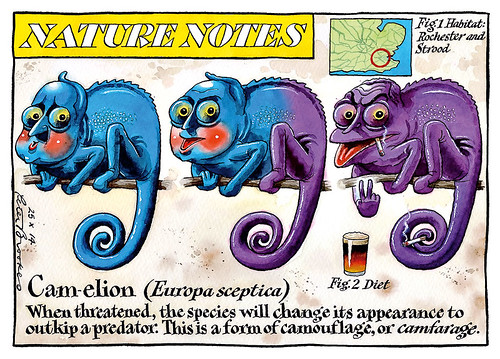
Afternoon
In the quiet of his space – ‘I need quiet, I can’t draw with a racket going on’ – he sets to work. Everything now is at Brookes’s disposal to make the most of the conceptual joke, to make it sing, and to make it sting. The watercolour adds a powerful intensity to the line work, and it is applied with a master’s touch. A small travel hairdryer now comes into its own as a key piece of kit, speeding the drying of the paint that Brookes applies, working layers quickly over one another.
Times editor John Witherow will not see the cartoon until it has reached its finished state. So as soon as the last brush strokes have been given the hairdryer treatment, Brookes walks from his office to the editor’s to show him tomorrow’s ‘oasis of anarchy’ (in the words of fellow cartoonist Martin Rowson, quoted in ‘Ambition and illustration’ in Eye 92). He then takes it along to the imaging department, who will scan it and let him do colour corrections. This last job done, he pulls on his hat and coat and heads home, not knowing what the news will dish up overnight.
As the great wartime cartoonist David Low once said, ‘Cartoonists are the permanent opposition,’ to which Brookes adds, ‘It’s true – there’s no such thing as a political cartoon in praise of something!’ As Times journalist and former MP Matthew Parris says, ‘His target is rarely the ideology of one politician or another. It is the vanity, inanity and mediocrity of the whole damn lot.’ His work can be vicious but there is no interference from above him at The Times to tone it down.
Brookes feels that his boundaries are tighter than the paper’s where taste is concerned. ‘No one is off-limits, but I have no interest in giving offence for the sake of it, that’s a mug’s game,’ he said when interviewed by his own paper. ‘I want to give offence in the context of what is happening politically. Cartoonists like myself don’t have answers, I am not a politician or a policy expert … all I can do is use common sense to make sense of the biggest issues of the day, as the readers do.’ Driver notes: ‘Peter doesn’t always think he’s right, he questions what he does. That’s what gives his work such quality.’
Peter Brookes and I spoke early one morning in the weeks following the UK ‘Brexit’ referendum. The ensuing chaos in UK politics had ushered in a period where big stories flared momentarily before an even more extraordinary story shoved all else aside. He looked energised and mischievous and ready to begin his working day. I pondered which would be worse as a politician – to face a rival across a despatch box, or to be in the crosshairs of Brookes’s pen. It did not take me long to decide on the wisdom of choosing the despatch box.
In the New Year’s Honours announced on 31 December 2016, Brookes was made a CBE (Companion of the Order of the British Empire). His response? ‘I am glad to live in a country that recognises cartoonists in this way. But I will keep on hitting hard.’
Brookes roughs out Tony Blair in pencil, pictured playing a supporting role in British PM David Cameron’s Libyan problem.
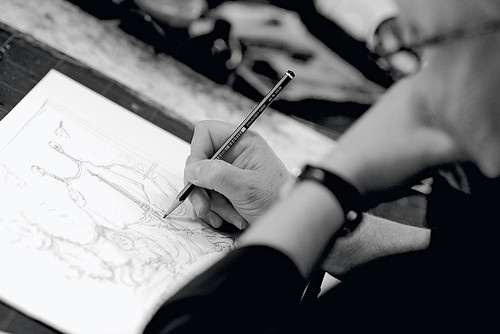
Martin Colyer, freelance art director, writer, London
First published in Eye no. 93 vol. 24, 2017
Eye is the world’s most beautiful and collectable graphic design journal, published quarterly for professional designers, students and anyone interested in critical, informed writing about graphic design and visual culture. It is available from all good design bookshops and online at the Eye shop, where you can buy subscriptions, back issues and single copies of the latest issue. You can see what Eye 93 looks like at Eye before You Buy on Vimeo.

